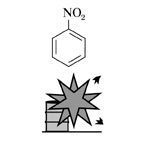| Case Name |
Explosion at a nitrobenzene distillation column due to the lowering of the degree of vacuum from power failure |
| Pictograph |

|
| Date |
March 2, 1951 |
| Place |
Wakayama prefecture, Japan |
| Location |
Chemical factory |
| Overview |
The distillation column exploded, when operation of the nitrobenzene distillation column of a nitrobenzene manufacturing plant stopped, and five workers were killed or injured. It is supposed that dinitrobenzene concentrated at the bottom of the distillation column and exploded by rise of the distillation temperature due to a vacuum drop from the abnormality of the power source, etc. |
| Incident |
A nitrobenzene distillation column of a nitrobenzene plant exploded just after the distillation work stopped. Five workers were killed or injured by the explosion, |
| Processing |
Manufacture |
| Individual Process |
Distillation |
| Process Flow |
Fig2.Unit process flow
|
| Substance |
Nitrobenzene, Fig3 |
| Type of Accident |
Explosion, Fire |
| Sequence |
Crude nitrobenzene which was manufactured by the nitration process was distilled in the distillation column at 40-60mmHg, 150-180 °C. The distillation column was charged with 700kg of crude nitrobenzene, and the distillation work stopped at the stage where 540kg was distilled. The distillation column exploded immediately after stopping distillation, and five workers were killed or injured. Besides, a power failure or a voltage drop happened by power sauce trouble while the distillation work. |
| Cause |
The accident seemed to occur by some reasons.
1. Dinitorobenzene that is a by-product of the nitrobenzene manufacturing existed in the distillation residue, and the concentration rose by the distillation.
2. The degree of vacuum decreased by a power failure or a voltage drop. As a result, the distillation temperature rose.
3. The impurities existed. |
| Countermeasures |
1. Taking measures to prevent accumulation of dinitrobenzene.
2. Taking measures for stable supply of the power sauce. For example, duplicating of the power supply and power lines in the factory.
3. Emergency shutdown of the heat source at a power failure.
4. Improvement of safety knowledge is most important. |
| Knowledge Comment |
A small amount of by-products generated in the reaction process sometimes concentrate in the distillation process and explosion and so on might occur. It is necessary to study the hazard of even a very small amount of by-products. |
| Background |
The accident seemed to occur due to insufficient study of the hazard of the process. For example, the case where a power failure happens when the concentration of dinitorobenzene increases by the distillation does not seem to have been assumed. |
| Incidental Discussion |
There is a method for adding the heavy stable solvent in order to avoid the concentration of hazardous materials at the bottom of the distillation column etc. These materials are called flux oil. |
| Reason for Adding to DB |
Example of accident caused due to byproducts in the chemical reaction |
| Scenario |
| Primary Scenario
|
Poor Value Perception, Poor Safety Awareness, Inadequate Risk Recognition, Insufficient Analysis or Research, Insufficient Prior Research, Insufficient Study at Unstable Condition, Planning and Design, Poor Planning, Inadequate Emergency Proedure, Usage, Operation/Use, Condensation, Bad Event, Electrical Failure, Power Failure, Malfunction, Poor Hardware, Stop of Vaccum Device, Secondary Damage, External Damage, Explosion, Bodily Harm, Death, 2 person died, Bodily Harm, Injury, 3 person injured, Loss to Organization, Economic Loss, Factory Complete Damage
|
|
| Sources |
Masamitsu Tamura, Masahide Wakakura, Explosion of the nitrobenzene distillation column. The reaction danger. -Accident case and analysis -, p.88(1995).
|
| Number of Deaths |
2 |
| Number of Injuries |
3 |
| Physical Damage |
A factory completely collapsed. |
| Financial Cost |
¥ 1.2 million. (The property insurance rate calculation association) |
| Multimedia Files |
Fig3.Chemical formula
|
| Field |
Chemicals and Plants
|
| Author |
OGAWA, Terushige (Graduate School of Environment and Information Sciences, Yokohama National University)
TAMURA, Masamitsu (Center for Risk Management and Safety Sciences, Yokohama National University)
|
|